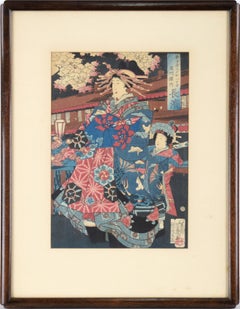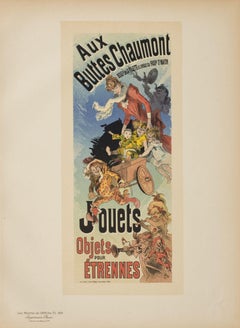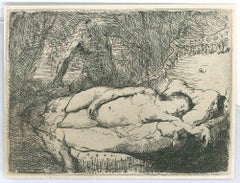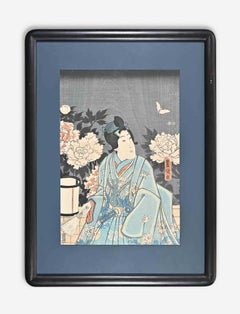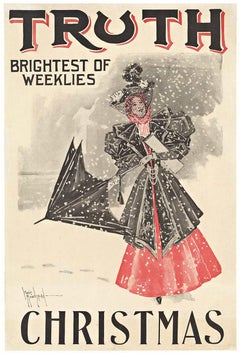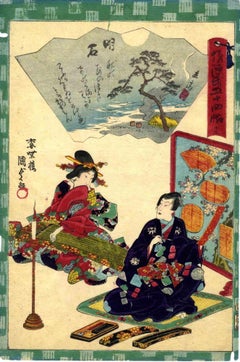19th Century Figurative Prints
to
346
6,303
1,006
182
50
40
Overall Width
to
Overall Height
to
5,405
354
123
55
34
25
16
7
2
269
123
115
112
102
3,530
7,597
25,433
6,813
292
597
1,408
1,236
1,327
2,299
3,258
5,194
2,840
1,347
3,028
4,463
3,075
41
5,243
2,673
2,075
1,786
1,525
1,056
862
574
547
510
507
502
433
291
243
239
228
220
208
197
4,334
2,106
682
675
445
325
5,652
4,093
764
Period: 19th Century
Courtesans at Yoshiwara Edomachi - Figurative Japanese Woodblock Print on Paper
Located in Soquel, CA
Courtesan at Yoshiwara Edomachi - Figurative Japanese Woodblock Print on Paper
Full color woodcut print of two women in elaborate gowns by Utagawa Yoshiiku (Ochiai Yoshiiku) (Japanese, 1833-1904). Two women are dressed in colorful robes with crossed arms. They are underneath a plum blossom tree in bloom, at night. In the background there is a building with many rooms. Valuable polychrome woodblock print of vertical large oban (大判) format made by Utagawa Yoshiiku (歌川芳幾), the famous artist also known as Ochiai Yoshiiku (落合芳幾), and depicting the courtesan Shizuka (しづか), of the house of pleasure Matsumotoro (松本楼), together with her young kamuro (禿) assistant. The couple is escorted by a kanabohiki (金棒引き) watchman holding a lantern and a metal rod with rings to make noise and alert the crowd.
The work, produced in August 1869 by the publisher Tsunajima Kamekichi (綱島亀吉), is taken from the “Twelve Months of Yoshiwara” (よし原十二ヶ月のうち), an elegant series of prints dedicated to the famous red light district of Edo (江戸), and is paired with the “month of leaves” Hazuki (葉月), that is August.
Ochiai Yoshiiku (Japanese, 1833-1904) was an ukiyo-e artist from the end of the Edo Period to the Meiji Period. He has created works which are essential to the history of ukiyo-e, such as“Twenty-eight Famous Murders with Verse”, a series of chimidoro-e (bloody paintings) which Yoshiiku and Tsukioka Yoshitoshi collaborated together, and “Shimbun (newspaper) Nishiki-e” that illustrated Meiji news articles with ukiyo-e.
Born the son of teahouse proprietor Asakusa Tamichi in 1833, Yoshiiku became a student of ukiyo-e artist Utagawa Kuniyoshi toward the end of the 1840s. His earliest known work dates to 1852 when he provided the backgrounds to some actor prints by his master.
Yoshiiku's earliest works were portraits of actors (yakusha-e), beauties (bijin-ga), and warriors (musha-e). He later followed Kuniyoshi into making satirical and humorous pieces, and became the leading name in the field after Kuniyosh's death in 1861. He illustrated the Tokyo Nichi Nichi...
Category
Impressionist 19th Century Figurative Prints
Materials
Paper, Ink, Woodcut
At the Buttes-Chaumont (Plate 169)
By Jules Chéret
Located in Greenwich, CT
At the Buttes-Chaumont (Plate 169) is an 1899 lithograph of Jules Chéret's poster, printed at Imprimerie Chaix by Jules Chéret and included in the famed collection of Belle Époque po...
Category
Art Nouveau 19th Century Figurative Prints
Materials
Paper, Lithograph
Jupiter and Antiope: Smaller Plat - Engraving after Rembrandt - 19th Century
Located in Roma, IT
Jupiter and Antiope: Smaller Plate on ivory-colored paper realized by Charles Amand Durand after an etching by Rembrandt dated 1631. This wonderful...
Category
Old Masters 19th Century Figurative Prints
Materials
Engraving
Kabuki Actor - Woodblock Print attr. to Utagawa Kunisada - Mid-19th Century
Located in Roma, IT
Kabuki Actor is an original Woodcut print realized in mid 19 century and attributed to Utagawa Kunisada.
Beautiful colored woodblock print, included a cardboard passpartout.
Includ...
Category
Modern 19th Century Figurative Prints
Materials
Woodcut
Original vintage poster "Truth" weekly magazine art nouveau lithograph
Located in Spokane, WA
Original vintage.poster: TRUTH CHRISTMAS. NOTE that this is the turn of the century original poster and is Not a magazine cover. The poster for a gossip magazine focusing on New...
Category
Art Nouveau 19th Century Figurative Prints
Materials
Lithograph
Meeting in Akashi - Woodcut Print by Utagawa Kunisada II - 1864
Located in Roma, IT
Meeting in Akashi is an original modern artwork realized by Utagawa Kunisada II and Hiroshige II in 1864.
Woodcut Print Oban Format.
From the series "Omo...
Category
Modern 19th Century Figurative Prints
Materials
Woodcut
Slow and Steady, Vanity Fair legal chromolithograph of a judge, 1900
Located in Melbourne, Victoria
Vanity Fair legal portrait of Justice Gainsford Bruce.
Sir Leslie Matthew Ward was a British portrait artist and caricaturist who over four decades painted 1,325 portraits which wer...
Category
Victorian 19th Century Figurative Prints
Materials
Lithograph
Reading news - Original Lithograph after Paul Gavarni - 1881
By Paul Gavarni
Located in Roma, IT
Reading news is an original lithograph artwork on ivory-colored paper, realized by the French draftsman Paul Gavarni (after, alias Guillaume Sulpice Chevalier Gavarni, 1804-1866) in ...
Category
Modern 19th Century Figurative Prints
Materials
Paper, Lithograph
$155 Sale Price
35% Off
Dante et Virgile - Original Etching by Lucian Carred - 1886
By Lucian Carred
Located in Roma, IT
Dante et Virgile is an original artwork realized by Lucian Carred in 1886. Original etching on paper.
Passepartout included (cm 32.5 x 50).
Artist Proof after Eugène Delacroix. Bon à tirer...
Category
Modern 19th Century Figurative Prints
Materials
Etching
Portrait of G. Heidegger - Original Etching by William Sharp - 1810
Located in Roma, IT
Portrait of G. Heidegger is an original artwork realized by William Sharp (1749 - 1824).
Original Etching from J.C. Lavater's "Essays on Physiognomy, De...
Category
Old Masters 19th Century Figurative Prints
Materials
Etching
Lincoln and His Family, Philadalphia 1866
Located in Paonia, CO
Lincoln and His Family, Philadelphia 1866 is a mezzotint engraving from the painting by Samual B. Waugh and engraved by prestigious engraver William Sartain. This family portrait...
Category
Other Art Style 19th Century Figurative Prints
Materials
Engraving
La Revue Blanche
Located in Palo Alto, CA
The wife of Thadée Nathanson, the editor of the French art and literary magazine La Revue Blanche, Misia Nathanson is presented here in beautiful form. Wonderfully strong but sparse line work mixed with soft curves and billowing forms are Lautrec signatures, but what is interesting is his respect for Misia is widely apparent. A white fur shawl...
Category
Modern 19th Century Figurative Prints
Materials
Lithograph
Genjie - Woodcut by Utagawa Kunisada - 1850
Located in Roma, IT
Genjie is an original artwork realized in 1850 by Utagawa Kunisada (1786-1865).
Oban yokoe.
From the series "Sono Sugata yukari no utsushi-e", 39th chapter.
Genji and his son Yug...
Category
Modern 19th Century Figurative Prints
Materials
Woodcut
The Conversation - Original Lithograph by Paul Gavarni - 1881
By Paul Gavarni
Located in Roma, IT
The Conversation is an original lithograph artwork on ivory-colored paper, realized by the French draftsman Paul Gavarni (after) (alias Guillaume Sulpice Chevalier Gavarni, 1804-1866...
Category
Modern 19th Century Figurative Prints
Materials
Lithograph
$167 Sale Price
30% Off
Kabuki Scene - Woodblock Print by Utagawa Kunisada - Mid-19th Century
Located in Roma, IT
Kabuki Scene is an original Woodcut print realized in mid 19 century by Utagawa Kunisada.
Good condition and Beautiful colored woodblock print.
This wonderful modern artwork repr...
Category
Modern 19th Century Figurative Prints
Materials
Woodcut
Composition with Monkeys - Etching by Thomas Landseer - 19th Century
By Thomas Landseer
Located in Roma, IT
Composition with Monkeys is an original artwork realized by Thomas Landseer (1795-1880) in the middle of the 19th century.
Original etching.
Good condition.
Draughtsman and printmaker, chiefly of animal and satirical subjects. Eldest son of the engraver John George Landseer. Studied with his brothers Charles and Edwin under Benjamin Robert Haydon, alongside Thomas Bewick...
Category
Modern 19th Century Figurative Prints
Materials
Etching
Ancient View of Niagara Waterfalls - Original Lithograph - 1850s
Located in Roma, IT
Ancient View of Niagara Waterfalls is an original modern artwork realized in Italy in the first half of the 19th Century.
Original Lithograph on Ivory Paper.
Inscripted in capital...
Category
Modern 19th Century Figurative Prints
Materials
Lithograph
Japanese Woodcut Print - Original Woodcut Print by Utagawa Hiroshige - 19th Cent
Located in Roma, IT
This is a superb polychrome woodblock print (nishiki-e, ink and color on paper), likely realized by Utagawa Hiroshige (Japanese, 1797-1858) at the middle of 19th century. This plate ...
Category
Modern 19th Century Figurative Prints
Materials
Woodcut
Egyptian Ruins - Lithograph after Karl Werner - 1881
Located in Roma, IT
Egyptian Ruins is a modern artwork realized d'apres Karl Werner.
Mixed colored cromolithograph.
The artwork is after the watercolor realized by the artist during a trip to Egypt b...
Category
Modern 19th Century Figurative Prints
Materials
Lithograph
Pochard - Woodcut Print by Alexander Francis Lydon - 1870
Located in Roma, IT
Pochard is a modern artwork realized in 1870 by the British artist Alexander Francis Lydon (1836-1917).
Woodcut print on ivory-colored paper.
...
Category
Modern 19th Century Figurative Prints
Materials
Woodcut
Portrait of Man While Writing - Original Etching by Thomas Holloway - 1810
Located in Roma, IT
Portrait of Man while writing is an original artwork realized by Thomas Holloway for Johann Caspar Lavater's "Essays on Physiognomy, Designed to promote the Knowledge and the Love of...
Category
Old Masters 19th Century Figurative Prints
Materials
Etching
A Woman from Harem - Hand Colored Lithograph - 19th century
Located in Roma, IT
A Woman from Harem is an original lithograph, Hand-colored on paper realized by an Anonymous artist of the XIX century, Titled on the lower center in Italian" Una Donna Dell'Harem".
...
Category
Modern 19th Century Figurative Prints
Materials
Lithograph
Los Ensacados - Etching - 1875
Located in Roma, IT
Los Ensacados - from Los Proverbios is an original black and white etching realized by Francisco Goya (1746-1828).
The artwork is the plate n. 8 from ...
Category
Old Masters 19th Century Figurative Prints
Materials
Etching, Aquatint
Sleeping Man - Etching + Pencil Drawing - Late 19th Century
Located in Roma, IT
Seeping Man is an etching on paper realized by Francois Blaise (1825-). Signed on the plate, with the same drawing in pencil on the rear, with an inscription on the lower center.
Th...
Category
Modern 19th Century Figurative Prints
Materials
Pencil, Etching
Fishermen - Original lithograph (1897/98)
Located in Paris, IDF
Auguste LEPERE (1849 - 1918)
Fishermen
Original litograph
1897/98
Printed on paper Vélin
Size 40 x 31 cm (c. 16 x 12")
INFORMATION : Published by 'Estampe Moderne, Paris, 1897-1...
Category
Art Nouveau 19th Century Figurative Prints
Materials
Lithograph
Temple of Neptune Pesto - Lithograph - 1862
Located in Roma, IT
Uses and Customs - Temple of Neptune Pesto is a lithograph on paper realized in 1862.
The artwork belongs to the Suite Uses and customs of all the peoples of the universe: " History...
Category
Modern 19th Century Figurative Prints
Materials
Lithograph
The Catacombs in Naples - Lithograph - 1862
Located in Roma, IT
Uses and Customs - The Catacombs in Naples is a lithograph on paper realized in 1862.
The artwork belongs to the Suite Uses and customs of all the peoples of the universe: " History...
Category
Modern 19th Century Figurative Prints
Materials
Lithograph
The Conversation - Original Lithograph by Paul Gavarni - 1881
By Paul Gavarni
Located in Roma, IT
The Conversation is an original lithograph artwork on ivory-colored paper, realized by the French draftsman Paul Gavarni (after) (alias Guillaume Sulpice Chevalier Gavarni, 1804-1866...
Category
Modern 19th Century Figurative Prints
Materials
Lithograph
L'ACTEUR . . . . - On voit bien qu'il fait chaud . . . . . . . trois spectateurs
Located in Fairlawn, OH
L'ACTEUR . . . . - On voit bien qu'il fait chaud . . . . . . . trois spectateurs dans la salle ..... faut-il commencer ? . . . .
LE DIRECTEUR .- Et encore un des trois est le vendeu...
Category
Romantic 19th Century Figurative Prints
Materials
Lithograph
View of Sepino - Original Lithograph by F- Cirelli - Mid 19th Century
Located in Roma, IT
Veduta di Sepino is an original artwork realized in the XIX Century by Cirelli.
Colored Lithograph on paper.
On the lower left corner the writing "P. Mattei di dal vero" and, on ...
Category
Old Masters 19th Century Figurative Prints
Materials
Lithograph
Judith & Holophernes - Etching by J.P.M. Jazet after H. Vernet - 19th Century
Located in Roma, IT
Judith & Holophernel is an original engraving, realized by Jean-Pierre-Marie Jazet after a painting of Horace Vernet.
In very good conditions.
The artwork represents the key scene of the story of Judith and Holophernes.
Horace Vernet (1789 -1863): The French painter of military and historical scenes Horace Vernet was born on 30 June 1789 in Paris at the Louvre, where his parents found refuge during the war. The artist mainly painted sports subjects and extensive battle scenes. Son and grandson of two well-known painters, Carle Vernet and Joseph Vernet, Horace developed a remarkable facility for working on a large scale making him one of the most important painters of military France. In favor of Napoleon Bonaparte, the painter specialized in glorifying the Napoleonic era with his art. During the restoration of the monarchy after 1815, his studio became a center of political intrigue, as well as a meeting place for sportsmen, artists and writers. One of his most famous paintings dates back to 1826, Battle of the Bridge of Arcole, and shows the young Napoleon grabbing a torn flag and leading his men across the bridge on November 17, 1796. After spending a period with the French army in Algiers (1833), Horace Vernet's works present elements of the Arab world. Later he also obtained commissions from Louis Philippe and Napoleon III to produce battle scene paintings...
Category
Old Masters 19th Century Figurative Prints
Materials
Etching
Hummingbirds - Etching by Johann Friedrich Naumann - 1840
Located in Roma, IT
Hummingbirds is an Etching hand colored realized by Gotthilf Heinrich von Schubert - Johann Friedrich Naumann, Illustration from Natural history of birds in pictures, published by St...
Category
Modern 19th Century Figurative Prints
Materials
Etching
Les Étudians de Paris - Original Lithograph by Paul Gavarni - 1847
Located in Roma, IT
Amusing original colored lithograph with pouchoir details.
Beautiful satiric illustration by the French draftsman Paul Gavarni (alias Guillaume Sulpice Chevalier Gavarni, 1804-1866...
Category
Modern 19th Century Figurative Prints
Materials
Lithograph
The Queen's Staircase - Original Lithograph by F.A. Pernot - 1836
Located in Roma, IT
The Queen's Staircase is an original modern artwork realized in 1836 by the French artist François Alexandre Pernot (1793-1865).
Original Lithograph on paper. The sheet is glued on ...
Category
Modern 19th Century Figurative Prints
Materials
Lithograph
A Merry Christmas original wood engraving by Thomas Nast 1880
Located in Paonia, CO
Thomas Nast is one of America’s great illustrators and is responsible for creating the image of Santa Claus as we know him today. This is a hand-colored wood engraving from the cover...
Category
Other Art Style 19th Century Figurative Prints
Materials
Woodcut
Column of Trajan in Rome: A Framed Original 19th C. Etching by Luigi Rossini
Located in Alamo, CA
This early 19th century etching entitled "Veduta dello scavo del Foro Trajano" was created by Luigi Rossini and included in his publication "Le Antichita Romane" (The Rome of Antiquity), published in Rome in 1823. It depicts the historical victory column of Trajan standing amidst the rubble of broken columns that remain around it.
The etching is presented in a black wood frame with a light brown outer mat and a dark brown inner mat. There are several frame abrasions. The print and mats are in very good condition. The frame measures 27" high, 29.07" wide and 0.5" deep. The print is framed and matted in the identical style as the another etching of an ancient Roman landmark, the Piazza Navona, which is also listed on 1stdibs, see item # LU117326144172. The pair would make an attractive display grouping of Roman architecture. A discount is available for purchase of the pair of prints.
Luigi Rossini (1790-1857) like his predecessors, Giovanni Piranesi (1720–1778) and Giuseppi Vasi (1710-1782), was an architect and artist. Like Piranesi and Vasi, he wanted to glorify the architecture of ancient Rome, which he felt was deteriorating and needed to be documented. Several of the ruins he illustrated have, in fact, since disappeared leaving only his images as a record of their appearance. His images of the grand edifices of the city dramatically depict the power and glory...
Category
Old Masters 19th Century Figurative Prints
Materials
Etching
William Shakespeare's "All's Well That Ends Well"after Wheatley- Etching - 1850s
Located in Roma, IT
William Shakespeare's "All's Well That Ends Well" after Wheatley is an etching realized in the 1850s.
Titled and text from play on the lower.
Good conditions with foxing.
This pri...
Category
Modern 19th Century Figurative Prints
Materials
Etching
French Costumes at the Time of Henry IV - Lithograph by Auguste Wahlen - 1844
Located in Roma, IT
French costumes at the time of Henry IV is a lithograph made by Auguste Wahlen in 1844.
Hand colored.
Good condition.
At the center of the artwork is the original title "Tav. IV. ...
Category
Modern 19th Century Figurative Prints
Materials
Lithograph
Miotsukushi - Woodcut Print by Utagawa Kunisada II - 1864
Located in Roma, IT
Miotsukushi is an original modern artwork realized by Utagawa Kunisada and Hiroshige II in 1864
Woodcut Print Oban Format.
From the series "Omokage Genji gojuyo" (In reference to t...
Category
Modern 19th Century Figurative Prints
Materials
Woodcut
Disparate de Carnaval - Etching - 1875
Located in Roma, IT
Disparate de Carnaval - from Los Proverbios is an original black and white etching realized by Francisco Goya (1746-1828).
The artwork is the plate n. ...
Category
Old Masters 19th Century Figurative Prints
Materials
Etching, Aquatint
Portrait of the Actor Kata - Woodcut Print by Sadayoshi Utagawa - 1848
Located in Roma, IT
Portrait of the actor Kataoka Gado II as Fukumasuya is an original modern artwork realized by Sadayoshi Utagawa in 1848.
Original Woodcut print Chuban Format.
Half-length portrait of the actor Kataoka Gado II as Fukumasuya Daisuke and his son Akeshi Tsuru Wakamaru.
Signed: Sadayoshi ga. Publisher: Shii.
Excellent impression with blindstamping (design in purple robe) and bokashi, slightly faded soiled yellowed and rubbed, centrefold.
Sadayoshi Utagawa was a printmaker and poet and presumably a pupil of Kunisada...
Category
Modern 19th Century Figurative Prints
Materials
Woodcut
Diseases of the Peritoneum - Lithograph By Ottavio Muzzi - 1843
Located in Roma, IT
Diseases of the Peritoneum is a lithograph hand colored by Ottavio Muzzi for the edition of Antoine Chazal,Human Anatomy, Printers Batelli and Ridolfi, realized in 1843.
Signed on p...
Category
Modern 19th Century Figurative Prints
Materials
Lithograph
Landscape from Fugaku Hyakkei- Woodcut Print by Katsushika Hokusai-1878
Located in Roma, IT
Landscape from "Fugaku hyakkei" is an original modern artwork realized by Katsushika Hokusai (31 October 1760 – 10 May 1849).
Original Woodcut print from the series "Fugaku Hyakkei" (100 views of Mount Fuji). From the second posthumous edition 1878.
Passepartout is included.
Publisher Eiraku Toshiro.
Sheet dimensions: 24 x 26 cm.
Good conditions. Signs of age and wear.
Hokusai created the monumental Thirty-Six Views of Mount Fuji both as a response to a domestic travel boom in Japan and as part of a personal obsession with Mount Fuji.
Katsushika Hokusai (31 October 1760 – 10 May 1849) known simply as Hokusai, was a Japanese artist, ukiyo-e painter and printmaker of the Edo period. Hokusai is best known for the woodblock print series Thirty-Six Views of Mount Fuji which includes the internationally iconic print The Great Wave off Kanagawa...
Category
Modern 19th Century Figurative Prints
Materials
Woodcut
The Conversation - Original Lithograph by Paul Gavarni - 1881
By Paul Gavarni
Located in Roma, IT
The conversation is an original lithograph on ivory-colored paper, realized by the French draftsman Paul Gavarni (after) (alias Guillaume Sulpice Chevalier Gavarni, 1804-1866) in Par...
Category
Modern 19th Century Figurative Prints
Materials
Paper, Lithograph
Horse Team - Original Etching by F. Jacque - Late 19th Century
By Frédéric Jacque
Located in Roma, IT
Horse Team is a black and white etching realized by Frederic Jacque in the late 19th Century.
The artwork represents a farmer and horses struggling with rural jobs
Good condition e...
Category
Naturalistic 19th Century Figurative Prints
Materials
Etching
Bijin and Children on a Porch with Lanterns-Woodcut by Utagawa Kunisada II-1870s
Located in Roma, IT
Bijin and children on a porch with lanterns is an original modern artworks realized by Utagawa Kunisada II between 1860-1875
Mixed colored woodcut print (nishiki-e).
Format: ôban vertical triptych...
Category
Modern 19th Century Figurative Prints
Materials
Woodcut
Dante - Etching, 1897
Located in Paris, IDF
Auguste RODIN (after)
Dante, 1897
Etching enhanced with watercolor
On vellum 42.5 x 31 cm (c. 16.7 x 12.2 inches)
Edition limited to 125 copies, send with the certificate of authent...
Category
Modern 19th Century Figurative Prints
Materials
Etching
Uses and Customs - Jupiter and Juno - Lithograph - 1862
Located in Roma, IT
Uses and Customs -Jupiter and Juno is a lithograph on paper realized in 1862.
The artwork belongs to the Suite Uses and customs of all the peoples of the universe: " History of the ...
Category
Modern 19th Century Figurative Prints
Materials
Lithograph
Cauliflower - Lithograph by Vincenzo Tenore - 1870s
Located in Roma, IT
Lithograph hand watercolored.
Belongs to the Series "Atlante di Botanica popolare ossia Illustrazione di Piante Notevoli di ogni famiglia" (Atlas of popular botany or illustration o...
Category
Modern 19th Century Figurative Prints
Materials
Lithograph
The Gigaro - Lithograph by Vincenzo Tenore - 1870s
Located in Roma, IT
Lithograph hand watercolored.
Belongs to the Series "Atlante di Botanica popolare ossia Illustrazione di Piante Notevoli di ogni famiglia" (Atlas of popular botany or illustration o...
Category
Modern 19th Century Figurative Prints
Materials
Lithograph
Japanese Figurative Edo Woodblock Set of Two
Located in Soquel, CA
Alluring two-piece edo woodblock print of Japanese actors by Toyohara Kunichika (Japanese, 1835-1900). Titled, dated and signed on verso. Presented...
Category
Edo 19th Century Figurative Prints
Materials
Paper, Ink, Woodcut
Venus zeigt Amor Psyche - Etching by Max Klinger - 1880
By Max Klinger
Located in Roma, IT
Etching and aquatint realized in 1880, belonging to the Series "Amor und Psyche", Opus V.
Ref. Singer 67, IV.
Excellent condition.
Category
Symbolist 19th Century Figurative Prints
Materials
Etching
Uses and Customs - Gravedona on Lake Como - Lithograph - 1862
Located in Roma, IT
Uses and Customs - Gravedona on Lake Como is a lithograph on paper realized in 1862.
The artwork belongs to the Suite Uses and customs of all the peoples of the universe: " History ...
Category
Modern 19th Century Figurative Prints
Materials
Lithograph
Uses and Customs - View of the Lake of Como taken from... - Lithograph - 1862
Located in Roma, IT
Uses and Customs - View of the Lake of Como taken from Bellagio is a lithograph on paper realized in 1862.
The artwork belongs to the Suite Uses and customs of all the peoples of th...
Category
Modern 19th Century Figurative Prints
Materials
Lithograph
Kabuki Scene: a Revenge Story - Woodcut by U. Kuniyoshi - 1846/52
Located in Roma, IT
Kabuki Scene: a Revenge Story is a wonderful color xylograph on paper, realized by the Japanese master Utagawa Kuniyoshi (1798-1861) between 1846-1852.
Japanese ideograms are print...
Category
Modern 19th Century Figurative Prints
Materials
Woodcut
Colonna Traiana - Lithograph on Paper by Pierre Duflos - 19th Century
Located in Roma, IT
Colonna Traiana is an original modern artwork realized in the first years of the XIX Century by the French artist Pierre Duflos (1742-1816).
Original ...
Category
19th Century Figurative Prints
Materials
Lithograph
Les Contes Drolatiques - Rare Book Illustrated by G. Doré - 1861
By Gustave Doré
Located in Roma, IT
Les Contes Drolatiques is an original modern rare book written by Honoré de Balzac (1799 – 1850) and illustrated by Gustave Doré (Strasbourg, 1832 – 23 January 1883) in 1861.
Publis...
Category
Modern 19th Century Figurative Prints
Materials
Paper, Etching
The Strength - Etching, 1897 (Goupil, Limited to 125 copies)
Located in Paris, IDF
Auguste RODIN (after)
The strength, 1897
Etching enhanced with watercolor
On vellum 31 x 42.5 cm (c. 12.2 x 16.7 inches)
Edition limited to 125 copies, send with the certificate of ...
Category
Modern 19th Century Figurative Prints
Materials
Etching
Queen's Amaryllis - Lithograph by Vincenzo Tenore - 1870s
Located in Roma, IT
Lithograph hand watercolored.
Belongs to the Series "Atlante di Botanica popolare ossia Illustrazione di Piante Notevoli di ogni famiglia" (Atlas of popular botany or illustration o...
Category
Modern 19th Century Figurative Prints
Materials
Lithograph
May Flower - original lithograph (1897-1898)
Located in Paris, IDF
Henri HERAN (1864 - 1946)
May Flower
Original lithograph
Printed signature, as issued
1897/98
Printed on paper Vélin (wove)
Size 40 x 31 cm (c. 16 x 12")...
Category
Art Nouveau 19th Century Figurative Prints
Materials
Lithograph
Recently Viewed
View AllMore Ways To Browse
Kim Tschang Yeul
Tom Blackwell On Sale
Tom Everhart Lithograph
Torii Kotondo
Victor Richardson
Vintage Boulangerie Signs
Vintage Les Nereides
Vintage Meat Scales
Vintage Multiplier Reel
Warhol Northwest Mask
Whistler Fumette
Yoko Ono Lithograph Harold Town
Zeno Giglietti
Ak47 Lotus
Alex Katz Bicycle
Alex Katz Christy
Alex Katz Twilight
Alex Katz Wedding Dress
